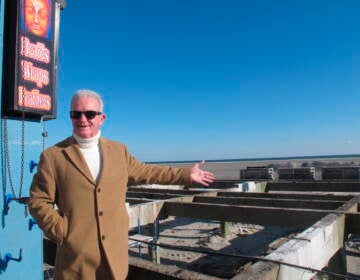Superstorm Sandy documentary shows recovery still ongoing, two years after the storm
If you visited Seaside Heights or its nearby towns this summer, you might have noticed that some houses look brand new while others remain in horrible shape. It’s clear that post-storm recovery is happening at a different speed for everyone. It’s something that has only become more apparent as time has gone by.
This Sunday, WHYY-TV will air the new documentary Heartbreak & Healing After Sandy, which is a comprehensive look at the rebuilding efforts over a two-year period.
Superstorm Sandy came ashore on Oct 29, 2012 and damaged or destroyed 365,000 homes in New Jersey, many of them along the central New Jersey coast.
The documentary is produced by Jersey Shore native Sandy Levine, of Toms River, who has been a television producer for 30 years. For the film, Levine chose to profile several different Ocean County families and businesses at every stage of their recovery. What’s clear by the end of the film is not everyone has a home to return to. ”Here’s what you see in virtually every waterfront neighborhood: an empty lot, next to a brand new house, next to a house that is untouched since the storm. You can tell, windows boarded up, weeds growing in the yard, obviously a house that was flooded and not touched,” said Levine, who emphasized that this is what she saw as recently as this past Sunday.
One of the most successful stories she profiles is that of Jimmy Ryan, who owns Harbour Yacht Club & Marina in Brick, N.J. The section of the barrier island he’s on is very narrow, so thin that the storm surge from Superstorm Sandy washed debris from battered oceanfront houses and sand into the water on the bay side of the island, where Ryan’s customers dock their boats. “On top of his boats tumbling around he had pieces of houses filling his marina and sand,” said Levine. Ryan didn’t wait for insurance money to come through and instead used part of his retirement savings to pay contractors to work through the frigid winter months to rebuild his docks before the spring boating season began in April 2013. “Within six months he had cleaned up a horrific mess and he was back in business,” said Levine.
But the story of why there are still so many empty lots and houses in disrepair has to do with the long wait for grant money and/or insurance payments. “The vast majority of the people I met took a long, long, long time to get their insurance payments,” said Levine. In addition, Levine says many homeowners, who had flood insurance, feel they did not get nearly enough to pay for the damages.
The other major factor in stalling the rebuilding effort, according to Levine, is the announcement of proposed new minimum home elevation requirements by FEMA. “It became clear that they had to either elevate their homes or their flood insurance was going to go way, way, way up.” The fact that FEMA’s new maps were just ”advisory” and not final created a paralysis for those deciding what to do. “So not only were people thinking we can’t afford to elevate our house they weren’t sure whether the maps were going to change,” said Levine. Eventually, FEMA did release new flood risk maps that reduced elevation requirements for many homes.
To only focus on homes being rebuilt and how high though would be to miss the point of Levine’s documentary, Heartbreak & Healing After Sandy. The film examines not only the physical and financial effects of the storm, but the emotional ones too. Some of the people in the film have experienced the trauma of losing everything they own when their homes washed away.
Recovering from the storm has been particularly difficult for the county’s many senior citizens. We meet 87-year-old John Mueller at an event to help homeowners navigate the many assistance programs. His home was damaged by the storm. He says with a half-hearted smile “It’s a new world,” followed by a chuckle. “The first thing out of their mouths, ‘We’ll fax it to you.’ Who has a fax machine? Or look it up on a computer. I just started doing a laptop two years ago. Finding my way. It’s not easy,” Mueller says. Then a few moments later we see Mueller, with his eyes red and tearing (likely a different point in Levine’s interview with him) “Well it’s some place we had figured on retiring and this is it…for the few years left.”
Levine wants viewers to know that despite all the heartbreak, healing is slowly taking place, too – at least for some. The huge debris piles are gone. In neighborhoods around the shore more and more rebuilding can be seen. And volunteers –both locals and strangers from around the country – continue to come to the aid of those in need. One woman interviewed in the film says the experience has made her stronger, and even brought her family closer together. Of the experience another says solemnly, “I wouldn’t wish it on my worst enemy.”
Heartbreak & Healing After Sandy airs on WHYY-TV Sunday, Nov 16, 2014 at 1:30 p.m.
WHYY is your source for fact-based, in-depth journalism and information. As a nonprofit organization, we rely on financial support from readers like you. Please give today.







